|
ACT III,
ADDENDUM 1
This first missive was sent in by reader Dennis:
One website I found helpful in the immediate aftermath of the
so-called collapses (at first referred to as being implosion-like, a
few times, by unwitting, but visually honest members of the news
industry), was
http://www.nyfsd.org/history.htm. This article
details the events surrounding a 12-alarm fire in a 34-storey
downtown Philadelphia high rise office building on January 23, 1991.
Of significance to the WTC 9/11 incidents, this high rise
(1) had a
structural design very similar to WTC 1 and 2,
(2) had a fire which
burnt out of control for 18 hours, and
(3) had 10 floors
destroyed...but DIDN'T COLLAPSE.
I mention this article because of
the importance this new study you cite gives to the supposed
catastrophic impact fire had on the WTC "collapses".
Until very recently, the 1991 Philadelphia fire, and
the First
Interstate Bank fire in Los Angeles on May 4, 1988, were the most
frequently cited comparisons to the Twin Tower fires. Both of those
earlier fires burned for much longer, and at far greater intensity,
than did the fires in the WTC towers, and yet both buildings somehow
managed to remain standing.
We now have an even more dramatic comparison. On the night of
February 12, the Windsor building in Madrid, Spain caught fire. The
32-story, steel-framed structure burned out of control for nearly
twenty-four hours, at temperatures approaching an astounding 1,500
degrees Fahrenheit. By the time the fire was brought under control,
the building had been reduced to little more than a steel skeleton.
And yet that skeleton remained standing.
Incredibly enough, the upper floors of the Windsor tower appear to
have partially collapsed, almost in a pancake-like fashion. What we
have here then is a slightly scaled-down version of almost exactly
what we are told happened at the World Trade Center towers: a raging
inferno, burning at unfathomably high temperatures, initiated a
partial collapse of the upper floors of a high-rise structure.
There is, of course, one major difference: the Windsor building did
not disappear into a cloud of dust.
Fire Engulfs Office Building in Madrid
By HAROLD HECKLE
Associated Press
MADRID, Spain Feb 12, 2005 — A raging fire swept through the upper
levels of a 32-story office building in downtown Madrid early
Sunday, melting it like a candle and collapsing the top floors in a
shower of flaming debris.
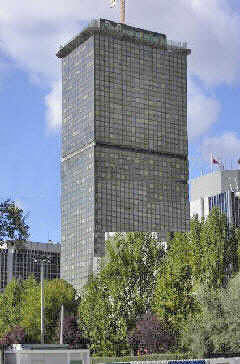 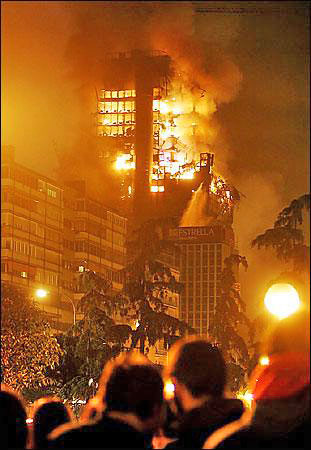
Bright orange flames shot out the sides of the
Windsor Building,
which is believed to be empty and is near one of Madrid's main
boulevards.
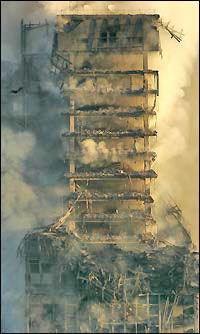 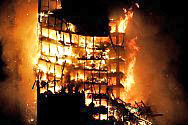 The fire started around 11:30 p.m. Saturday and was still burning
out of control about three hours later. At least nine upper stories
were on fire and muffled explosions could be heard in the building. The fire started around 11:30 p.m. Saturday and was still burning
out of control about three hours later. At least nine upper stories
were on fire and muffled explosions could be heard in the building.
The cause of the blaze was not immediately known, but emergency
services spokesman Javier Ayuso said it might have been a short
circuit.
City officials were afraid the building might collapse entirely.
"At this point the fire can't be fought and we have to wait," said
Pedro Calvo, the official in charge of the fire department and other
emergency services.
Firefighters and police evacuated nearby buildings and streets for
fear of a total collapse. Firefighters also started hosing down
neighboring office buildings to keep the fire from spreading.
Ayuso said three firefighters were treated for smoke inhalation and
exhaustion.
Construction of the Windsor Building, a landmark in Madrid's
business district, began in 1973 and was completed in 1979. It was
surrounded by scaffolding due to recent repairs, Ayuso said.
The building housed the offices of Deloite Touche Tohmatsu, a
multinational financial services company.
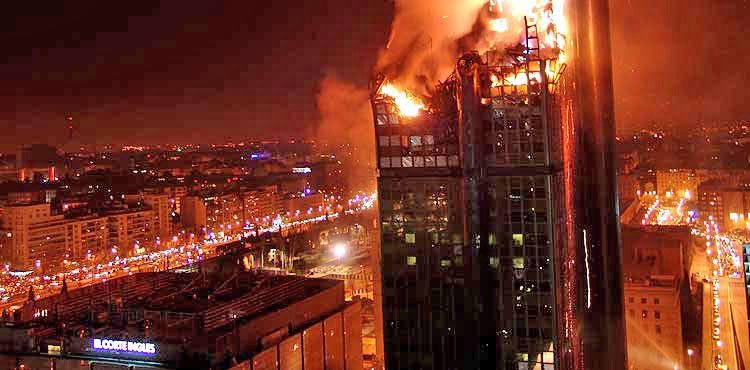
Collapse Threatens Skyscraper in Madrid
By ED MCCULLOUGH
Associated Press
Feb. 13, 2005 - Firefighters struggled for nearly 24 hours before
finally controlling Madrid's worst blaze in recent memory, which
reduced one of the city's tallest office buildings to a blackened
hulk of twisted wreckage.
Thick smoke and temperatures that soared as high as 1,472 degrees
Fahrenheit prevented firefighters from entering the 32-story Windsor
building until late Sunday. The fire, which left seven people
slightly injured, broke out Saturday just before midnight.
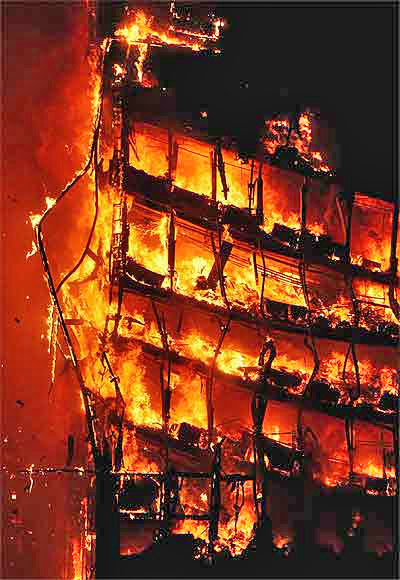
 The office tower was heavily damaged but did not collapse, as had
been feared. However, officials said it was unstable and closed the
area around the building. The office tower was heavily damaged but did not collapse, as had
been feared. However, officials said it was unstable and closed the
area around the building.
"What worries us now is its structural state because of the high
temperatures it was subjected to," said Merardo Tudelo, director of
the Madrid Municipal Firefighters.
Mayor Alberto Ruiz-Gallardon said "the situation is still critical."
Emergency officials planned to keep the area in the Spanish
capital's banking and business district cordoned off at least
through Monday.
Gallardon ordered nearby businesses to remain closed for the next
few days. Service on three subway lines running under or near the
building would also be curtailed, he said.
"This is the biggest fire ... this city has ever had,"
Gallardon
said.

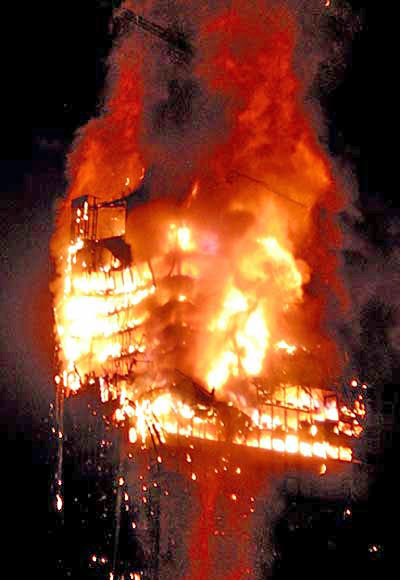
It was not immediately clear what caused the fire, but the building
was almost empty on Saturday night when the first alarm went off.
Only one of seven firefighters who suffered smoke inhalation
remained hospitalized Sunday, Gallardon said.
Construction of the shiny gold Windsor Building began in 1973 and
was completed in 1979. It became a landmark in Madrid's business
district. The building was surrounded with scaffolding due to recent
repairs, and a huge crane remained perched on its roof.
Firefighters battle Madrid inferno
MADRID, Spain -- A fire said to be the worst in Madrid's history
destroyed a skyscraper in the Spanish capital's financial district
on Sunday.
More than 100 firefighters worked to extinguish the blaze in the
city's eighth-tallest building, the 32-story Windsor Tower.
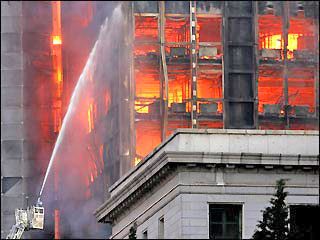 "The fire is not under control," Madrid Mayor
Alberto Ruiz Gallardon
told reporters. "We are all aware that we are fighting the biggest
fire that the city of Madrid has had in its entire history," he
said. "The fire is not under control," Madrid Mayor
Alberto Ruiz Gallardon
told reporters. "We are all aware that we are fighting the biggest
fire that the city of Madrid has had in its entire history," he
said.
"The fire department is making an extraordinary effort to stop the
fire spreading to surrounding buildings," he said.
The fire left seven people slightly injured, The Associated Press
reported. Thick smoke and searing temperatures were still preventing
firefighters from entering the building on Sunday night.
Gallardon told the AP the building was in danger of collapsing, and
ordered nearby businesses to remain closed for the next few days.
The operation of three subway lines running under or near the
damaged building would also be curtailed, he said.
It was not immediately clear what caused the fire.
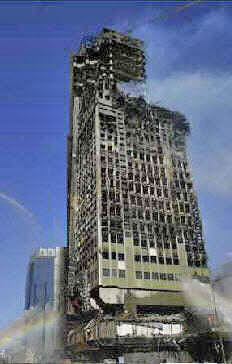 Magdalena Alvarez, minister of development, said a short circuit may
have started the fire, but it would be investigated. Magdalena Alvarez, minister of development, said a short circuit may
have started the fire, but it would be investigated.
Authorities said there was no reason to believe the fire was an act
of terrorism.
The building was almost empty when the first alarm went off. Only
one of the seven firefighters who suffered smoke inhalation remained
hospitalized Sunday, Gallardon told the AP.
Although the flames were no longer visible from outside by Sunday
night, gray smoke and ash stoked by gusts of wind continued to pour
from the blackened shell of the building.
Earlier in the day, several top floors collapsed onto lower ones,
the AP reported. Firefighter official Fernando Munilla said the
entire building -- which at about 106 meters (350 feet) high is
among the 10 tallest in Madrid -- could collapse.
"If the partial collapses keep happening, it would be lying to say
it's impossible that the whole building couldn't fall down," he
said.
Emergency crews at the scene said firefighters were waiting for the
temperature inside the building to drop, which they said would
lessen the danger of collapse.
At their peak, temperatures reached 800 degrees Celsius (1,472
Fahrenheit), said Javier Sanz, head of Madrid's firefighters.
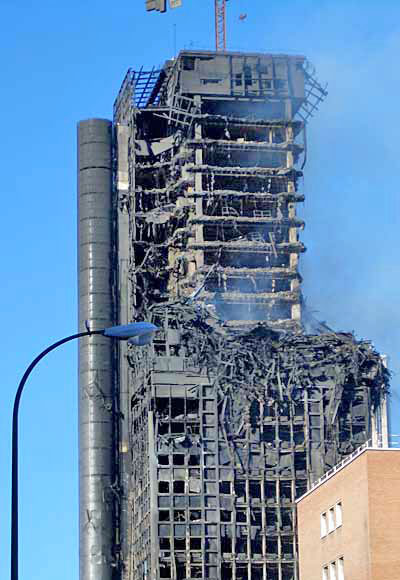
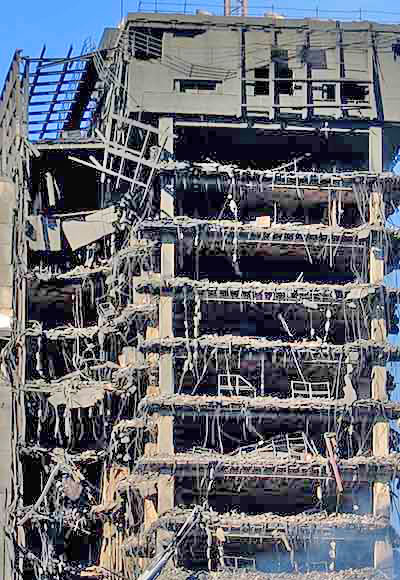
Construction of the shiny gold Windsor Building began in 1973 and
was completed in 1979. It became a landmark structure in Madrid's
business district. The building was surrounded with scaffolding
because of recent repairs, and a huge crane remained perched on its
roof.
There are troubling questions that need to be asked here about how
this fire started, how it spread so quickly, and why it burned with
such ferocity. But whatever the cause, it is clear from these images
that this was no run-of-the-mill fire. For nearly twenty-four hours,
the Windsor building sustained temperatures that, according to
official mythology, brought one of the Twin Towers down in less than
an hour. And despite the claims in these reports that the Windsor
tower melted "like a candle," or was reduced to a "blackened hulk of
twisted wreckage," the building's steel framework withstood the
inferno.
Notably, the entire core of the structure is still intact (and still
supporting the large crane temporarily mounted on the roof), as are
all of the lower floors of the building -- even though the tower
continued to burn at exceedingly high temperatures for many hours
after the partial collapses began. What the Windsor fire revealed,
quite dramatically, is that even if the WTC towers had been
subjected to ferocious fires, and even if those fires had instigated
the collapse of the upper floor assemblies, we are still lacking an
explanation for the complete and total destruction of the buildings.
So what was it again that caused the collapse of the Twin Towers
(and WTC7)?
When I posted Part III of this series, on October 27, 2004, the
National Institute of Standards and Technology (NIST) was hard at
work on a report that was allegedly going to explain how fires
brought the Twin Towers crashing down. Two weeks later, on November
11, Kevin Ryan of Underwriters Laboratories dispatched the following
letter to Dr. Frank Gayle of NIST.
The response to Ryan's correspondence was almost immediate:
Kevin
Ryan was fired.
Dr. Gayle,
Having recently reviewed your team's report of 10/19/04, I felt the
need to contact you directly.
As I'm sure you know, the company I work for certified the steel
components used in the construction of the WTC buildings. In
requesting information from both our CEO and Fire Protection
business manager last year, I learned that they did not agree on the
essential aspects of the story, except for one thing - that the
samples we certified met all requirements...
They suggested we all be patient and understand that UL was working
with your team, and that tests would continue through this year. I'm
aware of UL's attempts to help, including performing tests on models
of the floor assemblies. But the results of these tests appear to
indicate that the buildings should have easily withstood the thermal
stress caused by pools of burning jet fuel.
There continues to be a number of "experts" making public claims
about how the WTC buildings fell. One such person, Dr. Hyman Brown
from the WTC construction crew, claims that the buildings collapsed
due to fires at 2000F melting the steel (1). He states "What caused
the building to collapse is the airplane fuel… burning at 2,000
degrees Fahrenheit. The steel in that five-floor area melts."
Additionally, the newspaper that quotes him says "Just-released
preliminary findings from a National Institute of Standards and
Technology study of the World Trade Center collapse support Brown’s
theory."
We know that the steel components were certified to ASTM E119. The
time temperature curves for this standard require the samples to be
exposed to temperatures around 2000F for several hours. And as we
all agree, the steel applied met those specifications. Additionally,
I think we can all agree that even un-fireproofed steel will not
melt until reaching red-hot temperatures of nearly 3000F (2). Why
Dr. Brown would imply that 2000F would melt the high-grade steel
used in those buildings makes no sense at all.
The results of your recently published metallurgical tests seem to
clear things up (3), and support your team's August 2003 update as
detailed by the Associated Press (4), in which you were ready to
"rule out weak steel as a contributing factor in the collapse." The
evaluation of paint deformation and spheroidization seem very
straightforward, and you noted that the samples available were
adequate for the investigation. Your comments suggest that the steel
was probably exposed to temperatures of only about 500F (250C),
which is what one might expect from a thermodynamic analysis of the
situation.
However the summary of the new NIST report seems to
ignore your
findings, as it suggests that these low temperatures caused exposed
bits of the building’s steel core to "soften and buckle." (5)
Additionally this summary states that the perimeter columns
softened, yet your findings make clear that "most perimeter panels
(157 of 160) saw no temperature above 250C." To soften steel for the
purposes of forging, normally temperatures need to be above 1100C
(6). However, this new summary report suggests that much lower
temperatures were able to not only soften the steel in a matter of
minutes, but lead to rapid structural collapse.
This story just does not add up. If steel from those buildings did
soften or melt, I’m sure we can all agree that this was certainly
not due to jet fuel fires of any kind, let alone the briefly burning
fires in those towers. That fact should be of great concern to all
Americans. Alternatively, the contention that this steel did fail at
temperatures around 250C suggests that the majority of deaths on
9/11 were due to a safety-related failure. That suggestion should be
of great concern to my company.
There is no question that the events of 9/11 are the emotional
driving force behind the War on Terror. And the issue of the WTC
collapse is at the crux of the story of 9/11. My feeling is that
your metallurgical tests are at the crux of the crux of the crux.
Either you can make sense of what really happened to those
buildings, and communicate this quickly, or we all face the same
destruction and despair that come from global decisions based on
disinformation and “chatter”.
Thanks for your efforts to determine what happened on that day. You
may know that there are a number of other current and former
government employees that have risked a great deal to help us to
know the truth. I've copied one of these people on this message as a
sign of respect and support. I believe your work could also be a
nucleus of fact around which the truth, and thereby global peace and
justice, can grow again. Please do what you can to quickly eliminate
the confusion regarding the ability of jet fuel fires to soften or
melt structural steel.
1.
http://www.boulderweekly.com/archive/102104/coverstory.html
2. CRC Handbook of Chemistry and Physics, 61st edition, pg D-187
3.
http://wtc.nist.gov/media/P3MechanicalandMetAnalysisofSteel.pdf
4.
http://www.voicesofsept11.org/archive/911ic/082703.php
5.
http://wtc.nist.gov/media/NCSTACWTCStatusFINAL101904WEB2.pdf (pg
11)
6.
http://www.forging.org/FIERF/pdf/ffaaMacSleyne.pdf
Kevin Ryan
Site Manager
Environmental Health Laboratories
A Division of Underwriters Laboratories
|



 The fire started around 11:30 p.m. Saturday and was still burning
out of control about three hours later. At least nine upper stories
were on fire and muffled explosions could be heard in the building.
The fire started around 11:30 p.m. Saturday and was still burning
out of control about three hours later. At least nine upper stories
were on fire and muffled explosions could be heard in the building.

 The office tower was heavily damaged but did not collapse, as had
been feared. However, officials said it was unstable and closed the
area around the building.
The office tower was heavily damaged but did not collapse, as had
been feared. However, officials said it was unstable and closed the
area around the building.

 "The fire is not under control," Madrid Mayor
Alberto Ruiz Gallardon
told reporters. "We are all aware that we are fighting the biggest
fire that the city of Madrid has had in its entire history," he
said.
"The fire is not under control," Madrid Mayor
Alberto Ruiz Gallardon
told reporters. "We are all aware that we are fighting the biggest
fire that the city of Madrid has had in its entire history," he
said. Magdalena Alvarez, minister of development, said a short circuit may
have started the fire, but it would be investigated.
Magdalena Alvarez, minister of development, said a short circuit may
have started the fire, but it would be investigated.
